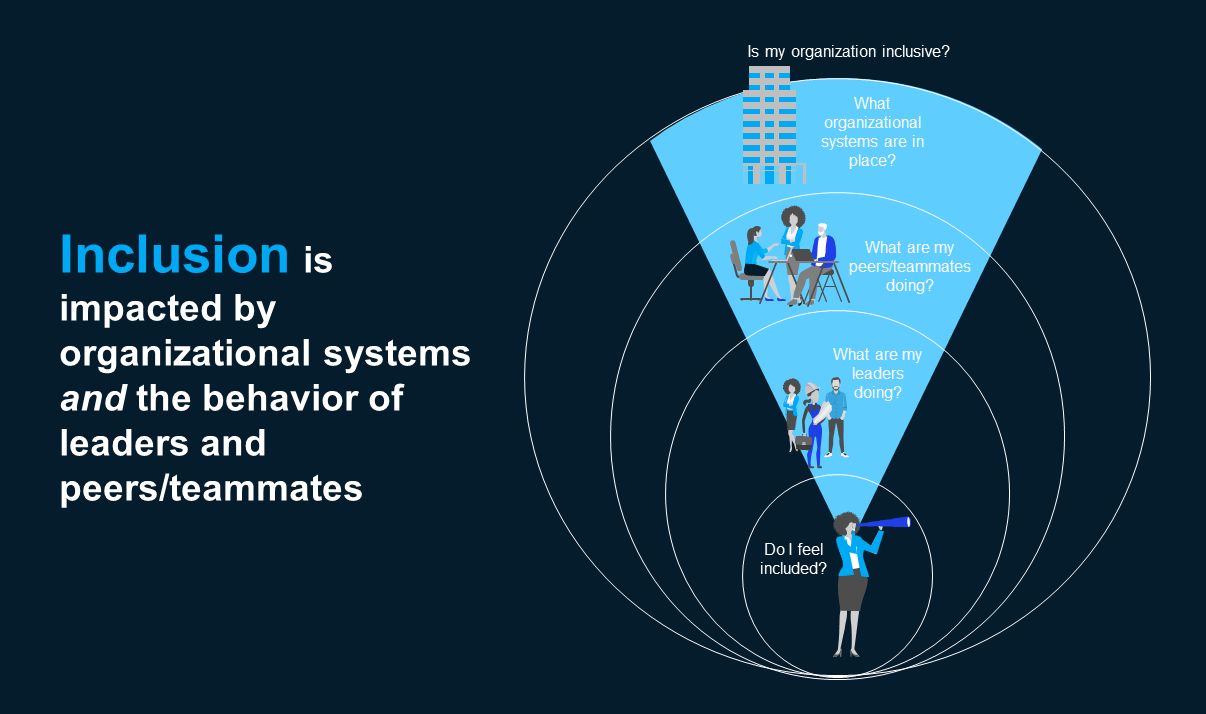Recent and urgent reckonings about race and sexual harassment have brought diversity, equity, and inclusion (DE&I) front of mind for employers. Organizations that implement DE&I assessments and strategies enable high-performance cultures, protect themselves from reputational risk, and concretely demonstrate commitment to organizational values, which all positively impact business performance. Perhaps most importantly, though, is that organizations are recognizing that pursuing DE&I is the right thing to do for society.
Company-wide policies are a vital component to achieve DE&I, but they alone are insufficient to foster high levels of inclusion. Our research finds that there are three key relationships that shape inclusion for employees: organizational systems, leaders, and peers/teammates.

Organizational systems are “table stakes”
Policies and practices to create a welcoming culture free from discrimination are now considered “table stakes.” Systems that help establish fair employee decisions, equal access to resources, a sense of teamwork, protection from mistreatment, work-life balance, and the ability to bring authentic selves to work are becoming increasingly expected by employees and considered the bare minimum.
The importance of these systems cannot be downplayed. For example, a 2006 review by Dr. Alexandra Kaley and colleagues shows that institutional DE&I initiatives generally succeed in boosting the representation of women and minority racial/ethnic group members into management. However, simply having these systems is not enough. To be effective, organizations must execute on them through leadership support, peer/teammate allyship, and broad accountability.
Inclusion relies on interpersonal relationships
While organizational systems to facilitate inclusion are essential, employees may interact with them infrequently and those interactions tend to be quite impersonal. It is instead the daily behaviors by, and personal interactions with, leaders and peers/teammates that make or break inclusive workplaces.
Our research shows that when employees experience inclusive behaviors from their leaders (e.g., mentorship, impartial treatment, advocacy, team building, encouragement in decision making) and peers/teammates (e.g., allyship, empowerment and support, genuine concern, mutual respect, integration of diverse ideas), they are more likely to report feeling included at work regardless of whether their organization has any formal inclusion systems in place. Inversely, when interpersonal interactions are hostile, harassing, abusive, or undermining (e.g., overt and subtle microaggressions), there is a serious and impending threat to inclusion.
Take the example of a North American energy company that was struggling to execute its DE&I commitments. Our inclusion assessment revealed that while their systems supported inclusion, leaders did not openly support or encourage employees to take advantage of inclusive policies. As a result, minority-group employees viewed inclusion systems as just an empty “ticking-the-box” exercise. In response, the company introduced a new competency model related to inclusive leadership and tied yearly bonuses to improving inclusion. The “table stakes” systems set the foundation for inclusion, but it took shifting leadership behaviors and relationships between leaders and employees to truly move the needle.
Conclusion
Slogans, policies, trainings, fancy marketing, or communication campaigns alone do not create inclusion. Inclusion comes by also changing how employees and leaders behave toward each other, designing supporting organizational systems, and actively encouraging employees to leverage these systems. To make meaningful shifts in interpersonal relationships, employees must understand how their behaviors contribute to or detract from inclusion and then adopt easy, concrete ways to act differently. Our next post in this series will cover the key behaviors peers/teammates, leaders, and systems can enact to foster inclusion.
The authors would like to thank Diana Ellsworth, Ruth Imose, Laura London, and David Mendelsohn for their meaningful contributions to this post.


